Exploring Business Management: An Annotated Bibliography of Key Topics
VerifiedAdded on 2023/06/09
|11
|2294
|427
Annotated Bibliography
AI Summary
This annotated bibliography delves into various crucial topics within business management, drawing from reputable journal articles. It covers organizational structure, emphasizing the role of ownership in fostering innovation. It examines environmental forces and their impact on competitive advantage, highlighting the importance of dynamic capabilities and environmental analysis. The bibliography also addresses risks confronting firms, particularly focusing on data security in the context of SaaS adoption by small businesses. Furthermore, it differentiates between temporary and sustainable competitive advantages, exploring how companies can leverage resources for long-term success. Finally, it investigates the influence of transformational leadership and cultural diversity on innovation within multinational organizations. The bibliography concludes by emphasizing the critical need for data protection and risk management in online environments, particularly for organizations handling sensitive student information. Desklib provides access to this and other solved assignments for students.
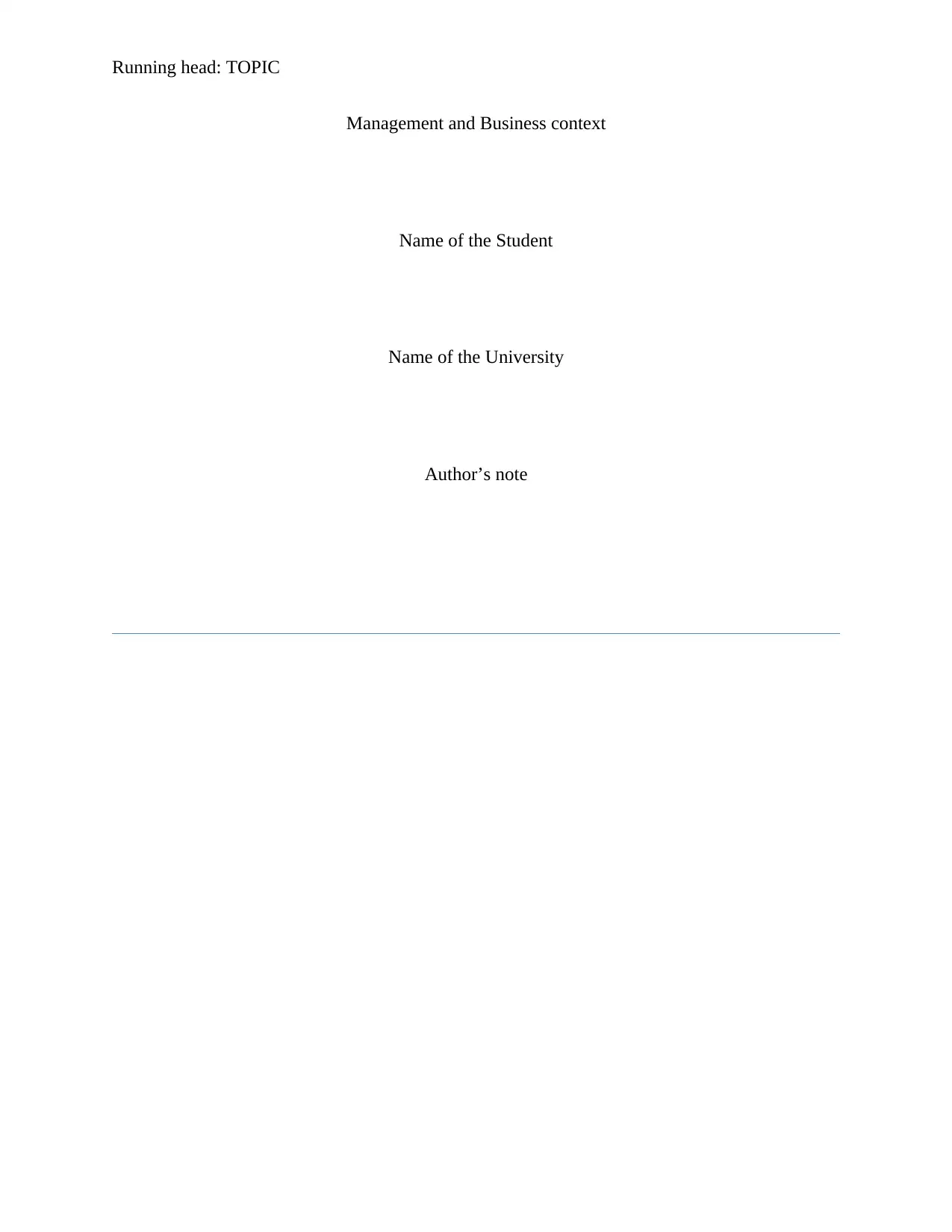
Running head: TOPIC
Management and Business context
Name of the Student
Name of the University
Author’s note
Management and Business context
Name of the Student
Name of the University
Author’s note
Paraphrase This Document
Need a fresh take? Get an instant paraphrase of this document with our AI Paraphraser
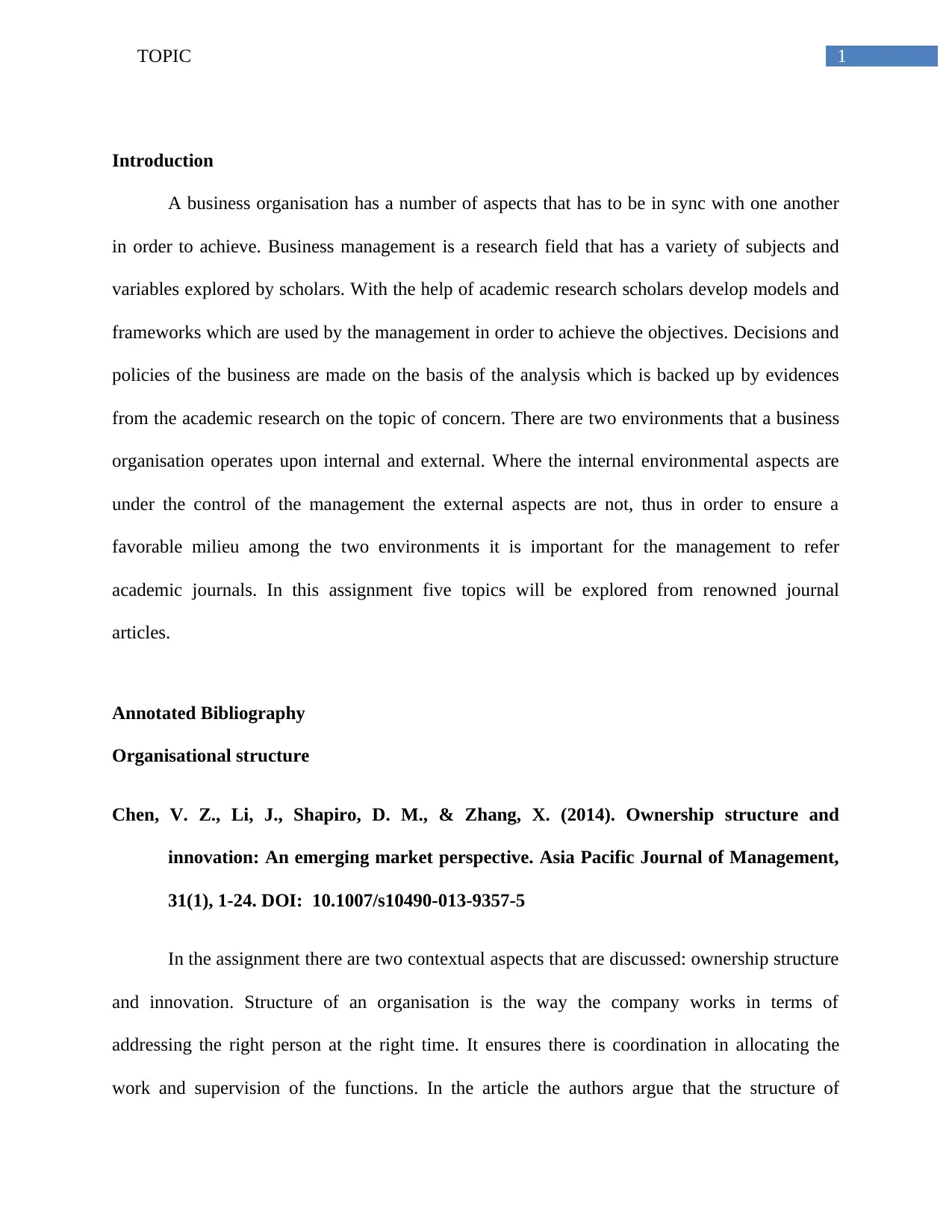
1TOPIC
Introduction
A business organisation has a number of aspects that has to be in sync with one another
in order to achieve. Business management is a research field that has a variety of subjects and
variables explored by scholars. With the help of academic research scholars develop models and
frameworks which are used by the management in order to achieve the objectives. Decisions and
policies of the business are made on the basis of the analysis which is backed up by evidences
from the academic research on the topic of concern. There are two environments that a business
organisation operates upon internal and external. Where the internal environmental aspects are
under the control of the management the external aspects are not, thus in order to ensure a
favorable milieu among the two environments it is important for the management to refer
academic journals. In this assignment five topics will be explored from renowned journal
articles.
Annotated Bibliography
Organisational structure
Chen, V. Z., Li, J., Shapiro, D. M., & Zhang, X. (2014). Ownership structure and
innovation: An emerging market perspective. Asia Pacific Journal of Management,
31(1), 1-24. DOI: 10.1007/s10490-013-9357-5
In the assignment there are two contextual aspects that are discussed: ownership structure
and innovation. Structure of an organisation is the way the company works in terms of
addressing the right person at the right time. It ensures there is coordination in allocating the
work and supervision of the functions. In the article the authors argue that the structure of
Introduction
A business organisation has a number of aspects that has to be in sync with one another
in order to achieve. Business management is a research field that has a variety of subjects and
variables explored by scholars. With the help of academic research scholars develop models and
frameworks which are used by the management in order to achieve the objectives. Decisions and
policies of the business are made on the basis of the analysis which is backed up by evidences
from the academic research on the topic of concern. There are two environments that a business
organisation operates upon internal and external. Where the internal environmental aspects are
under the control of the management the external aspects are not, thus in order to ensure a
favorable milieu among the two environments it is important for the management to refer
academic journals. In this assignment five topics will be explored from renowned journal
articles.
Annotated Bibliography
Organisational structure
Chen, V. Z., Li, J., Shapiro, D. M., & Zhang, X. (2014). Ownership structure and
innovation: An emerging market perspective. Asia Pacific Journal of Management,
31(1), 1-24. DOI: 10.1007/s10490-013-9357-5
In the assignment there are two contextual aspects that are discussed: ownership structure
and innovation. Structure of an organisation is the way the company works in terms of
addressing the right person at the right time. It ensures there is coordination in allocating the
work and supervision of the functions. In the article the authors argue that the structure of
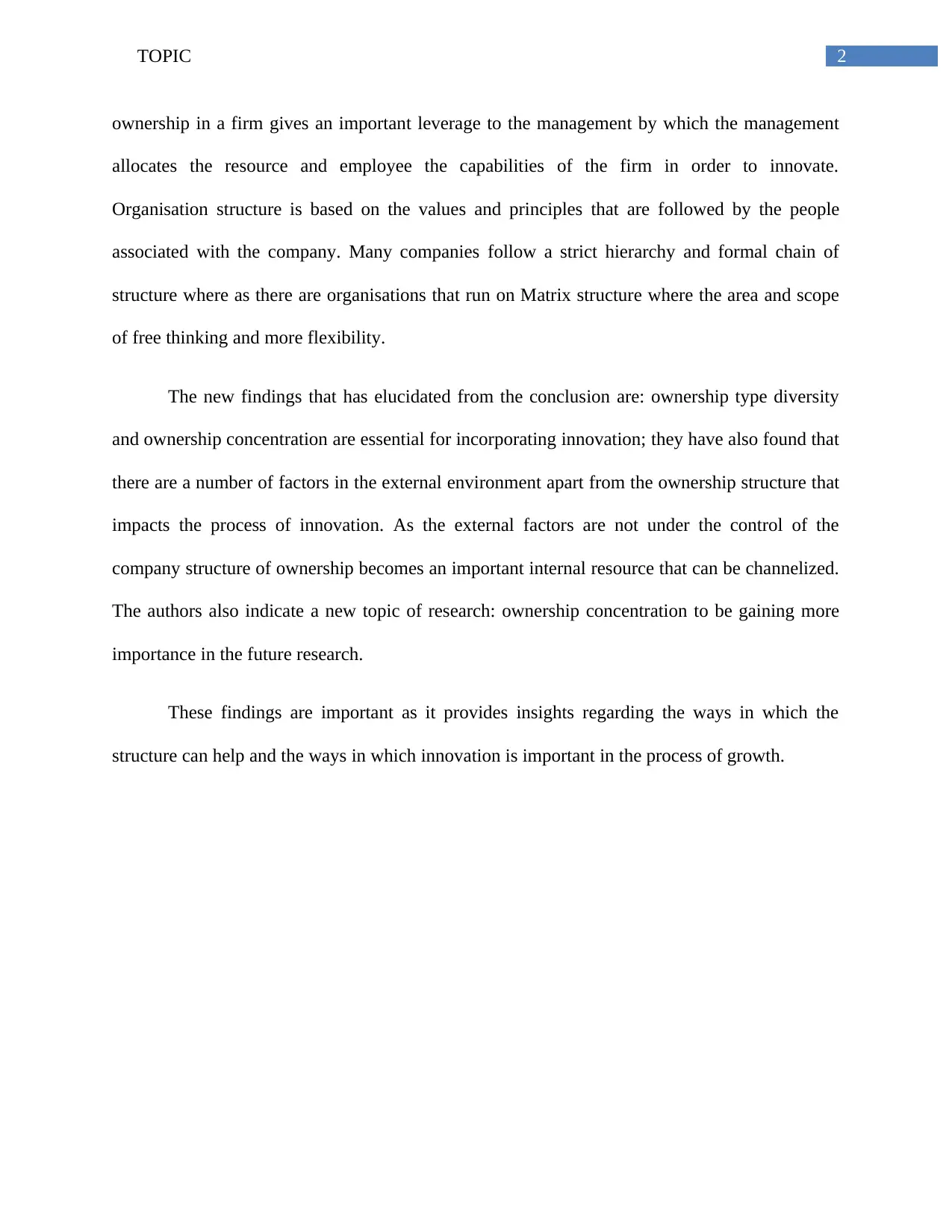
2TOPIC
ownership in a firm gives an important leverage to the management by which the management
allocates the resource and employee the capabilities of the firm in order to innovate.
Organisation structure is based on the values and principles that are followed by the people
associated with the company. Many companies follow a strict hierarchy and formal chain of
structure where as there are organisations that run on Matrix structure where the area and scope
of free thinking and more flexibility.
The new findings that has elucidated from the conclusion are: ownership type diversity
and ownership concentration are essential for incorporating innovation; they have also found that
there are a number of factors in the external environment apart from the ownership structure that
impacts the process of innovation. As the external factors are not under the control of the
company structure of ownership becomes an important internal resource that can be channelized.
The authors also indicate a new topic of research: ownership concentration to be gaining more
importance in the future research.
These findings are important as it provides insights regarding the ways in which the
structure can help and the ways in which innovation is important in the process of growth.
ownership in a firm gives an important leverage to the management by which the management
allocates the resource and employee the capabilities of the firm in order to innovate.
Organisation structure is based on the values and principles that are followed by the people
associated with the company. Many companies follow a strict hierarchy and formal chain of
structure where as there are organisations that run on Matrix structure where the area and scope
of free thinking and more flexibility.
The new findings that has elucidated from the conclusion are: ownership type diversity
and ownership concentration are essential for incorporating innovation; they have also found that
there are a number of factors in the external environment apart from the ownership structure that
impacts the process of innovation. As the external factors are not under the control of the
company structure of ownership becomes an important internal resource that can be channelized.
The authors also indicate a new topic of research: ownership concentration to be gaining more
importance in the future research.
These findings are important as it provides insights regarding the ways in which the
structure can help and the ways in which innovation is important in the process of growth.
⊘ This is a preview!⊘
Do you want full access?
Subscribe today to unlock all pages.

Trusted by 1+ million students worldwide
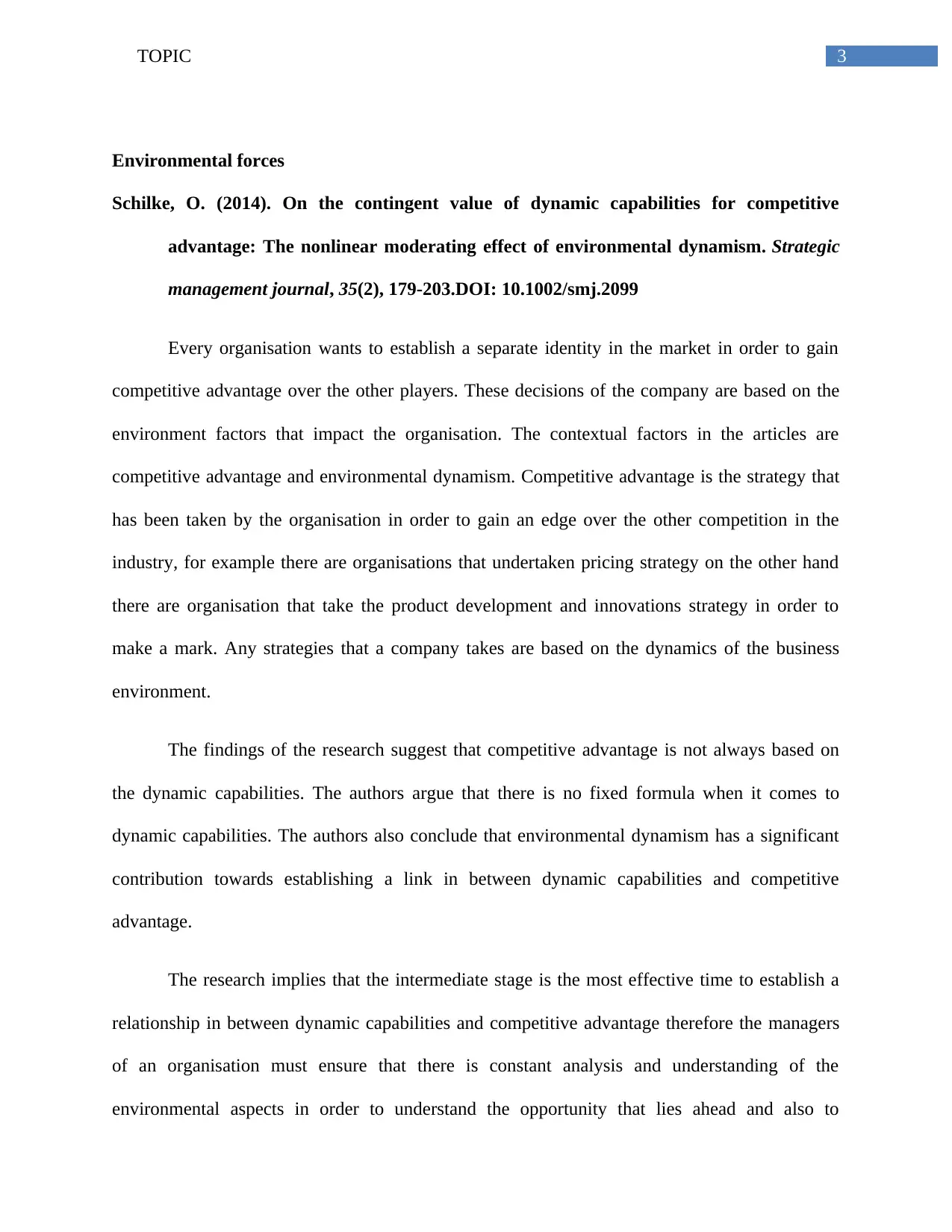
3TOPIC
Environmental forces
Schilke, O. (2014). On the contingent value of dynamic capabilities for competitive
advantage: The nonlinear moderating effect of environmental dynamism. Strategic
management journal, 35(2), 179-203.DOI: 10.1002/smj.2099
Every organisation wants to establish a separate identity in the market in order to gain
competitive advantage over the other players. These decisions of the company are based on the
environment factors that impact the organisation. The contextual factors in the articles are
competitive advantage and environmental dynamism. Competitive advantage is the strategy that
has been taken by the organisation in order to gain an edge over the other competition in the
industry, for example there are organisations that undertaken pricing strategy on the other hand
there are organisation that take the product development and innovations strategy in order to
make a mark. Any strategies that a company takes are based on the dynamics of the business
environment.
The findings of the research suggest that competitive advantage is not always based on
the dynamic capabilities. The authors argue that there is no fixed formula when it comes to
dynamic capabilities. The authors also conclude that environmental dynamism has a significant
contribution towards establishing a link in between dynamic capabilities and competitive
advantage.
The research implies that the intermediate stage is the most effective time to establish a
relationship in between dynamic capabilities and competitive advantage therefore the managers
of an organisation must ensure that there is constant analysis and understanding of the
environmental aspects in order to understand the opportunity that lies ahead and also to
Environmental forces
Schilke, O. (2014). On the contingent value of dynamic capabilities for competitive
advantage: The nonlinear moderating effect of environmental dynamism. Strategic
management journal, 35(2), 179-203.DOI: 10.1002/smj.2099
Every organisation wants to establish a separate identity in the market in order to gain
competitive advantage over the other players. These decisions of the company are based on the
environment factors that impact the organisation. The contextual factors in the articles are
competitive advantage and environmental dynamism. Competitive advantage is the strategy that
has been taken by the organisation in order to gain an edge over the other competition in the
industry, for example there are organisations that undertaken pricing strategy on the other hand
there are organisation that take the product development and innovations strategy in order to
make a mark. Any strategies that a company takes are based on the dynamics of the business
environment.
The findings of the research suggest that competitive advantage is not always based on
the dynamic capabilities. The authors argue that there is no fixed formula when it comes to
dynamic capabilities. The authors also conclude that environmental dynamism has a significant
contribution towards establishing a link in between dynamic capabilities and competitive
advantage.
The research implies that the intermediate stage is the most effective time to establish a
relationship in between dynamic capabilities and competitive advantage therefore the managers
of an organisation must ensure that there is constant analysis and understanding of the
environmental aspects in order to understand the opportunity that lies ahead and also to
Paraphrase This Document
Need a fresh take? Get an instant paraphrase of this document with our AI Paraphraser
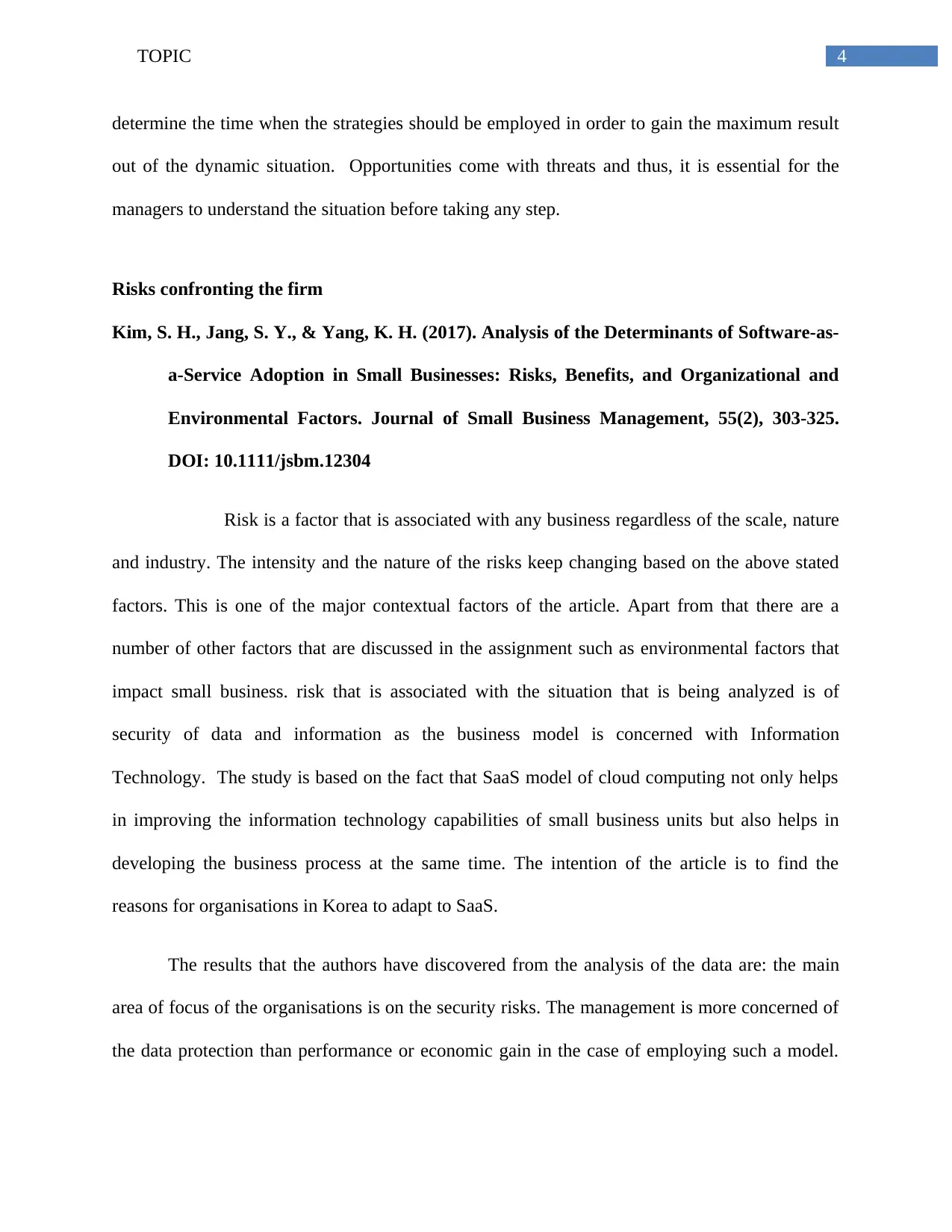
4TOPIC
determine the time when the strategies should be employed in order to gain the maximum result
out of the dynamic situation. Opportunities come with threats and thus, it is essential for the
managers to understand the situation before taking any step.
Risks confronting the firm
Kim, S. H., Jang, S. Y., & Yang, K. H. (2017). Analysis of the Determinants of Software‐as‐
a‐Service Adoption in Small Businesses: Risks, Benefits, and Organizational and
Environmental Factors. Journal of Small Business Management, 55(2), 303-325.
DOI: 10.1111/jsbm.12304
Risk is a factor that is associated with any business regardless of the scale, nature
and industry. The intensity and the nature of the risks keep changing based on the above stated
factors. This is one of the major contextual factors of the article. Apart from that there are a
number of other factors that are discussed in the assignment such as environmental factors that
impact small business. risk that is associated with the situation that is being analyzed is of
security of data and information as the business model is concerned with Information
Technology. The study is based on the fact that SaaS model of cloud computing not only helps
in improving the information technology capabilities of small business units but also helps in
developing the business process at the same time. The intention of the article is to find the
reasons for organisations in Korea to adapt to SaaS.
The results that the authors have discovered from the analysis of the data are: the main
area of focus of the organisations is on the security risks. The management is more concerned of
the data protection than performance or economic gain in the case of employing such a model.
determine the time when the strategies should be employed in order to gain the maximum result
out of the dynamic situation. Opportunities come with threats and thus, it is essential for the
managers to understand the situation before taking any step.
Risks confronting the firm
Kim, S. H., Jang, S. Y., & Yang, K. H. (2017). Analysis of the Determinants of Software‐as‐
a‐Service Adoption in Small Businesses: Risks, Benefits, and Organizational and
Environmental Factors. Journal of Small Business Management, 55(2), 303-325.
DOI: 10.1111/jsbm.12304
Risk is a factor that is associated with any business regardless of the scale, nature
and industry. The intensity and the nature of the risks keep changing based on the above stated
factors. This is one of the major contextual factors of the article. Apart from that there are a
number of other factors that are discussed in the assignment such as environmental factors that
impact small business. risk that is associated with the situation that is being analyzed is of
security of data and information as the business model is concerned with Information
Technology. The study is based on the fact that SaaS model of cloud computing not only helps
in improving the information technology capabilities of small business units but also helps in
developing the business process at the same time. The intention of the article is to find the
reasons for organisations in Korea to adapt to SaaS.
The results that the authors have discovered from the analysis of the data are: the main
area of focus of the organisations is on the security risks. The management is more concerned of
the data protection than performance or economic gain in the case of employing such a model.
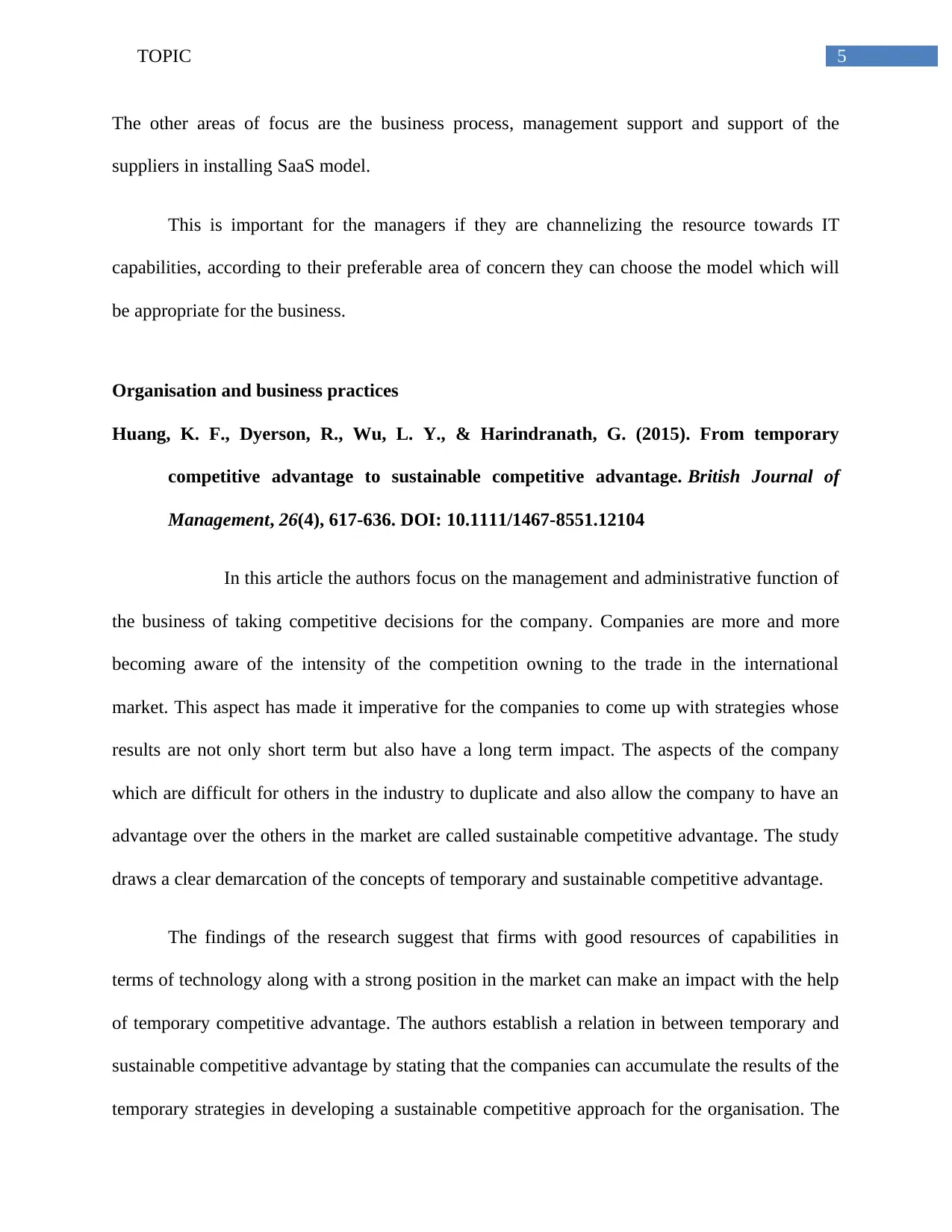
5TOPIC
The other areas of focus are the business process, management support and support of the
suppliers in installing SaaS model.
This is important for the managers if they are channelizing the resource towards IT
capabilities, according to their preferable area of concern they can choose the model which will
be appropriate for the business.
Organisation and business practices
Huang, K. F., Dyerson, R., Wu, L. Y., & Harindranath, G. (2015). From temporary
competitive advantage to sustainable competitive advantage. British Journal of
Management, 26(4), 617-636. DOI: 10.1111/1467-8551.12104
In this article the authors focus on the management and administrative function of
the business of taking competitive decisions for the company. Companies are more and more
becoming aware of the intensity of the competition owning to the trade in the international
market. This aspect has made it imperative for the companies to come up with strategies whose
results are not only short term but also have a long term impact. The aspects of the company
which are difficult for others in the industry to duplicate and also allow the company to have an
advantage over the others in the market are called sustainable competitive advantage. The study
draws a clear demarcation of the concepts of temporary and sustainable competitive advantage.
The findings of the research suggest that firms with good resources of capabilities in
terms of technology along with a strong position in the market can make an impact with the help
of temporary competitive advantage. The authors establish a relation in between temporary and
sustainable competitive advantage by stating that the companies can accumulate the results of the
temporary strategies in developing a sustainable competitive approach for the organisation. The
The other areas of focus are the business process, management support and support of the
suppliers in installing SaaS model.
This is important for the managers if they are channelizing the resource towards IT
capabilities, according to their preferable area of concern they can choose the model which will
be appropriate for the business.
Organisation and business practices
Huang, K. F., Dyerson, R., Wu, L. Y., & Harindranath, G. (2015). From temporary
competitive advantage to sustainable competitive advantage. British Journal of
Management, 26(4), 617-636. DOI: 10.1111/1467-8551.12104
In this article the authors focus on the management and administrative function of
the business of taking competitive decisions for the company. Companies are more and more
becoming aware of the intensity of the competition owning to the trade in the international
market. This aspect has made it imperative for the companies to come up with strategies whose
results are not only short term but also have a long term impact. The aspects of the company
which are difficult for others in the industry to duplicate and also allow the company to have an
advantage over the others in the market are called sustainable competitive advantage. The study
draws a clear demarcation of the concepts of temporary and sustainable competitive advantage.
The findings of the research suggest that firms with good resources of capabilities in
terms of technology along with a strong position in the market can make an impact with the help
of temporary competitive advantage. The authors establish a relation in between temporary and
sustainable competitive advantage by stating that the companies can accumulate the results of the
temporary strategies in developing a sustainable competitive approach for the organisation. The
⊘ This is a preview!⊘
Do you want full access?
Subscribe today to unlock all pages.

Trusted by 1+ million students worldwide
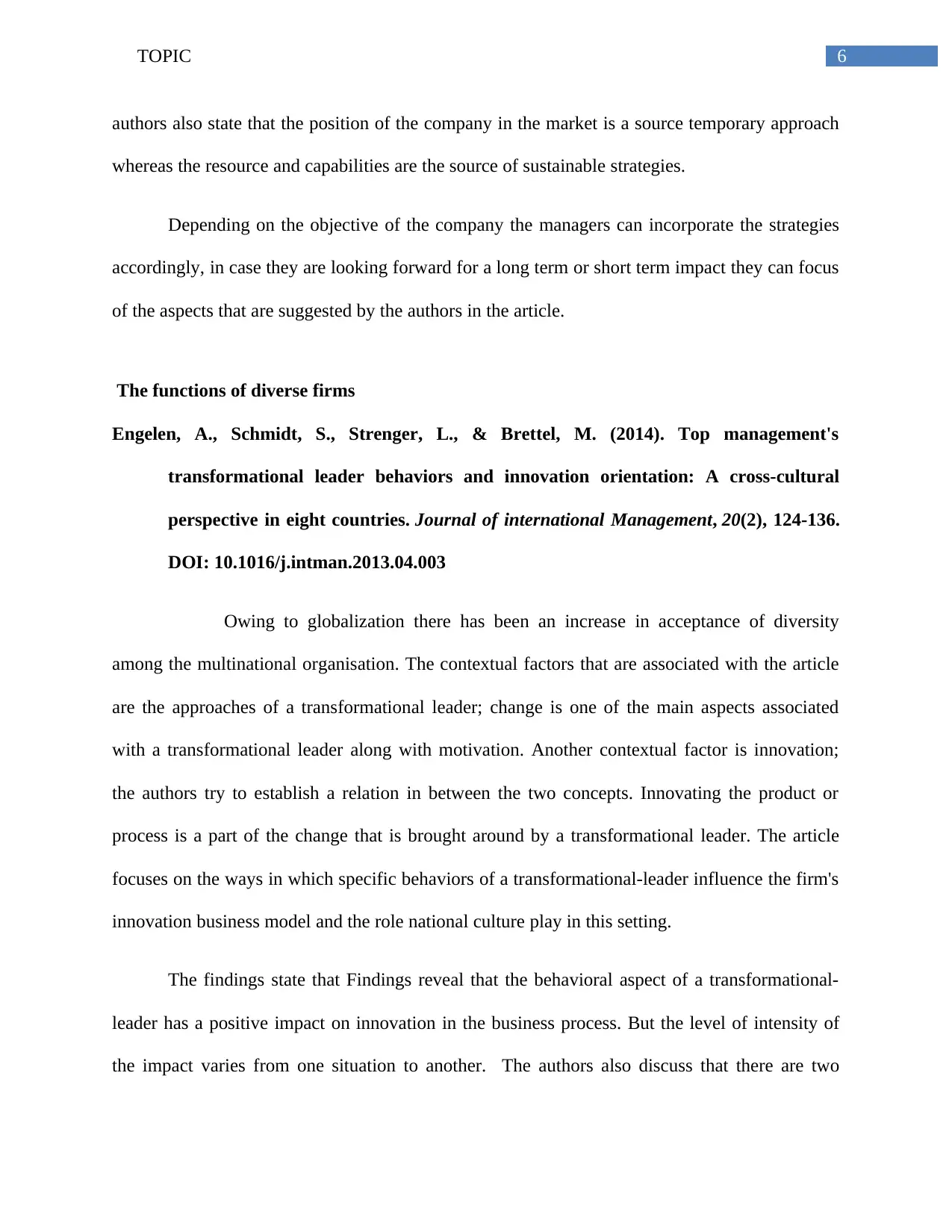
6TOPIC
authors also state that the position of the company in the market is a source temporary approach
whereas the resource and capabilities are the source of sustainable strategies.
Depending on the objective of the company the managers can incorporate the strategies
accordingly, in case they are looking forward for a long term or short term impact they can focus
of the aspects that are suggested by the authors in the article.
The functions of diverse firms
Engelen, A., Schmidt, S., Strenger, L., & Brettel, M. (2014). Top management's
transformational leader behaviors and innovation orientation: A cross-cultural
perspective in eight countries. Journal of international Management, 20(2), 124-136.
DOI: 10.1016/j.intman.2013.04.003
Owing to globalization there has been an increase in acceptance of diversity
among the multinational organisation. The contextual factors that are associated with the article
are the approaches of a transformational leader; change is one of the main aspects associated
with a transformational leader along with motivation. Another contextual factor is innovation;
the authors try to establish a relation in between the two concepts. Innovating the product or
process is a part of the change that is brought around by a transformational leader. The article
focuses on the ways in which specific behaviors of a transformational-leader influence the firm's
innovation business model and the role national culture play in this setting.
The findings state that Findings reveal that the behavioral aspect of a transformational-
leader has a positive impact on innovation in the business process. But the level of intensity of
the impact varies from one situation to another. The authors also discuss that there are two
authors also state that the position of the company in the market is a source temporary approach
whereas the resource and capabilities are the source of sustainable strategies.
Depending on the objective of the company the managers can incorporate the strategies
accordingly, in case they are looking forward for a long term or short term impact they can focus
of the aspects that are suggested by the authors in the article.
The functions of diverse firms
Engelen, A., Schmidt, S., Strenger, L., & Brettel, M. (2014). Top management's
transformational leader behaviors and innovation orientation: A cross-cultural
perspective in eight countries. Journal of international Management, 20(2), 124-136.
DOI: 10.1016/j.intman.2013.04.003
Owing to globalization there has been an increase in acceptance of diversity
among the multinational organisation. The contextual factors that are associated with the article
are the approaches of a transformational leader; change is one of the main aspects associated
with a transformational leader along with motivation. Another contextual factor is innovation;
the authors try to establish a relation in between the two concepts. Innovating the product or
process is a part of the change that is brought around by a transformational leader. The article
focuses on the ways in which specific behaviors of a transformational-leader influence the firm's
innovation business model and the role national culture play in this setting.
The findings state that Findings reveal that the behavioral aspect of a transformational-
leader has a positive impact on innovation in the business process. But the level of intensity of
the impact varies from one situation to another. The authors also discuss that there are two
Paraphrase This Document
Need a fresh take? Get an instant paraphrase of this document with our AI Paraphraser
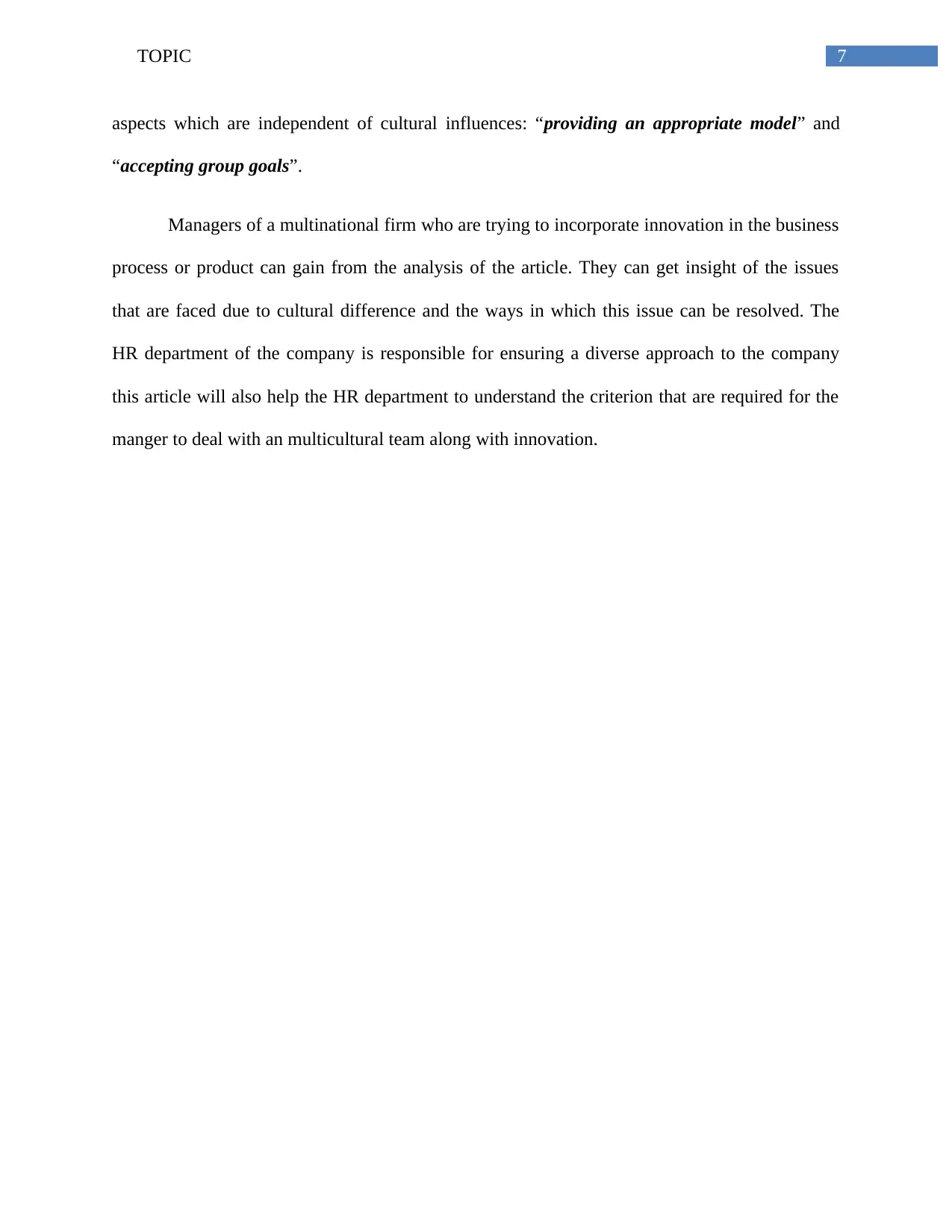
7TOPIC
aspects which are independent of cultural influences: “providing an appropriate model” and
“accepting group goals”.
Managers of a multinational firm who are trying to incorporate innovation in the business
process or product can gain from the analysis of the article. They can get insight of the issues
that are faced due to cultural difference and the ways in which this issue can be resolved. The
HR department of the company is responsible for ensuring a diverse approach to the company
this article will also help the HR department to understand the criterion that are required for the
manger to deal with an multicultural team along with innovation.
aspects which are independent of cultural influences: “providing an appropriate model” and
“accepting group goals”.
Managers of a multinational firm who are trying to incorporate innovation in the business
process or product can gain from the analysis of the article. They can get insight of the issues
that are faced due to cultural difference and the ways in which this issue can be resolved. The
HR department of the company is responsible for ensuring a diverse approach to the company
this article will also help the HR department to understand the criterion that are required for the
manger to deal with an multicultural team along with innovation.
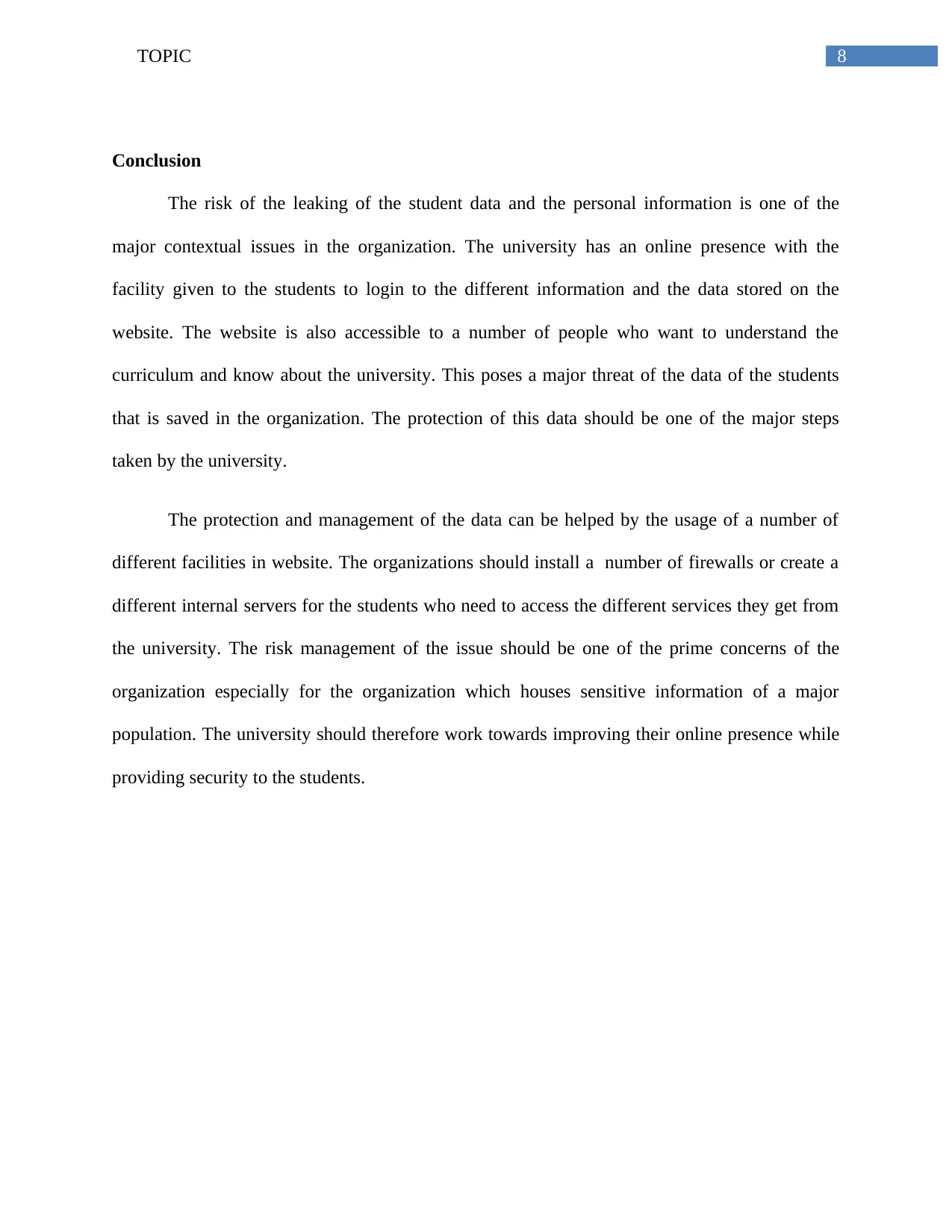
8TOPIC
Conclusion
The risk of the leaking of the student data and the personal information is one of the
major contextual issues in the organization. The university has an online presence with the
facility given to the students to login to the different information and the data stored on the
website. The website is also accessible to a number of people who want to understand the
curriculum and know about the university. This poses a major threat of the data of the students
that is saved in the organization. The protection of this data should be one of the major steps
taken by the university.
The protection and management of the data can be helped by the usage of a number of
different facilities in website. The organizations should install a number of firewalls or create a
different internal servers for the students who need to access the different services they get from
the university. The risk management of the issue should be one of the prime concerns of the
organization especially for the organization which houses sensitive information of a major
population. The university should therefore work towards improving their online presence while
providing security to the students.
Conclusion
The risk of the leaking of the student data and the personal information is one of the
major contextual issues in the organization. The university has an online presence with the
facility given to the students to login to the different information and the data stored on the
website. The website is also accessible to a number of people who want to understand the
curriculum and know about the university. This poses a major threat of the data of the students
that is saved in the organization. The protection of this data should be one of the major steps
taken by the university.
The protection and management of the data can be helped by the usage of a number of
different facilities in website. The organizations should install a number of firewalls or create a
different internal servers for the students who need to access the different services they get from
the university. The risk management of the issue should be one of the prime concerns of the
organization especially for the organization which houses sensitive information of a major
population. The university should therefore work towards improving their online presence while
providing security to the students.
⊘ This is a preview!⊘
Do you want full access?
Subscribe today to unlock all pages.

Trusted by 1+ million students worldwide
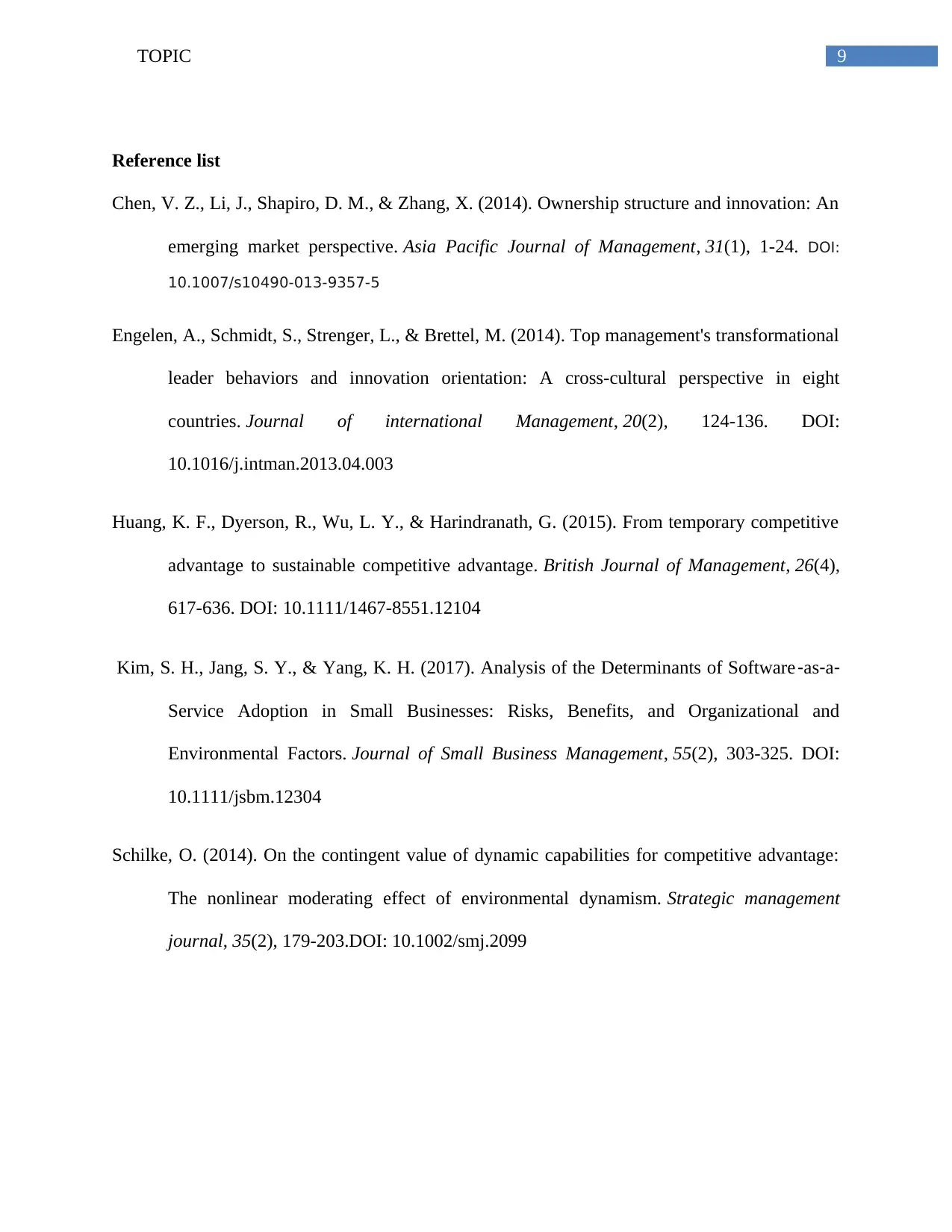
9TOPIC
Reference list
Chen, V. Z., Li, J., Shapiro, D. M., & Zhang, X. (2014). Ownership structure and innovation: An
emerging market perspective. Asia Pacific Journal of Management, 31(1), 1-24. DOI:
10.1007/s10490-013-9357-5
Engelen, A., Schmidt, S., Strenger, L., & Brettel, M. (2014). Top management's transformational
leader behaviors and innovation orientation: A cross-cultural perspective in eight
countries. Journal of international Management, 20(2), 124-136. DOI:
10.1016/j.intman.2013.04.003
Huang, K. F., Dyerson, R., Wu, L. Y., & Harindranath, G. (2015). From temporary competitive
advantage to sustainable competitive advantage. British Journal of Management, 26(4),
617-636. DOI: 10.1111/1467-8551.12104
Kim, S. H., Jang, S. Y., & Yang, K. H. (2017). Analysis of the Determinants of Software‐as‐a‐
Service Adoption in Small Businesses: Risks, Benefits, and Organizational and
Environmental Factors. Journal of Small Business Management, 55(2), 303-325. DOI:
10.1111/jsbm.12304
Schilke, O. (2014). On the contingent value of dynamic capabilities for competitive advantage:
The nonlinear moderating effect of environmental dynamism. Strategic management
journal, 35(2), 179-203.DOI: 10.1002/smj.2099
Reference list
Chen, V. Z., Li, J., Shapiro, D. M., & Zhang, X. (2014). Ownership structure and innovation: An
emerging market perspective. Asia Pacific Journal of Management, 31(1), 1-24. DOI:
10.1007/s10490-013-9357-5
Engelen, A., Schmidt, S., Strenger, L., & Brettel, M. (2014). Top management's transformational
leader behaviors and innovation orientation: A cross-cultural perspective in eight
countries. Journal of international Management, 20(2), 124-136. DOI:
10.1016/j.intman.2013.04.003
Huang, K. F., Dyerson, R., Wu, L. Y., & Harindranath, G. (2015). From temporary competitive
advantage to sustainable competitive advantage. British Journal of Management, 26(4),
617-636. DOI: 10.1111/1467-8551.12104
Kim, S. H., Jang, S. Y., & Yang, K. H. (2017). Analysis of the Determinants of Software‐as‐a‐
Service Adoption in Small Businesses: Risks, Benefits, and Organizational and
Environmental Factors. Journal of Small Business Management, 55(2), 303-325. DOI:
10.1111/jsbm.12304
Schilke, O. (2014). On the contingent value of dynamic capabilities for competitive advantage:
The nonlinear moderating effect of environmental dynamism. Strategic management
journal, 35(2), 179-203.DOI: 10.1002/smj.2099
Paraphrase This Document
Need a fresh take? Get an instant paraphrase of this document with our AI Paraphraser

10TOPIC
1 out of 11
Related Documents
Your All-in-One AI-Powered Toolkit for Academic Success.
+13062052269
info@desklib.com
Available 24*7 on WhatsApp / Email
![[object Object]](/_next/static/media/star-bottom.7253800d.svg)
Unlock your academic potential
Copyright © 2020–2025 A2Z Services. All Rights Reserved. Developed and managed by ZUCOL.



